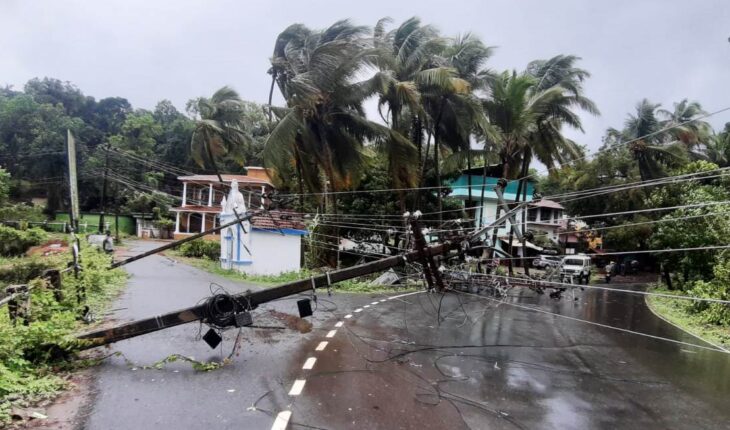By Dominick Rodrigues
Mumbai/Goa : Cyclone Tauktae stormed its way through several states of India on a rampage that left many cities devastated in its wake with trails of uprooted trees, fallen dwellings and floods – all amidst a population already reeling under deadly effects of the covid-19 pandemic.
However, even as the population struggled to recover from the stormy battering, the Indian Meteorological Department announced on May 19 the likelihood of another cyclone hitting India on May 26-27 – but on India’s East Coast this time. A low pressure area forming over north Andaman Sea and Bay of Bengal on May 22 was likely to intensify gradually into a cyclonic storm to move northwest toi reach the Bengal and Odisha coasts by May 26 evening, the IMD stated.
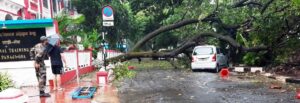
Meanwhile, Cyclone Tauktae had wound its way up the western coastline – often moving inlandwards along several states like Karnataka, Goa and Maharashtra.
Cyclone Tauktae’s aftermath witnessed Prime Minister Narendra Modi doing an aerial survey of affected areas in Gujarat and announcing assistance of Rs 1,000 crore for immediate relief work in the state. He announced an ex-gratia of Rs. 2 lakh to the next of kin of the deceased and Rs. 50,000 to the seriously injured in the States of Kerala, Karnataka, Goa, Maharashtra, Gujarat, Rajasthan and the UTs of Daman and Diu, and Dadra and Nagar Haveli.
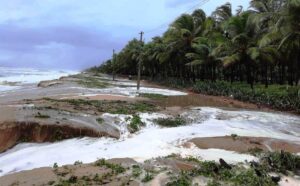
“Let the panchnama be completed first,” Maharashtra Chief Minister Uddhav Thackeray said while assuring immediate and adequate compensation for those adversely affected and also promising to carry out a 360-degree SWOT framework analysis of the actual devastation caused by Cyclone Tauktae.
Thackeray held a review meeting in Ratnagiri on the Konkan Coast following a day-long tour of the cyclone-hit regions in Ratnagiri and Sindhdurg districts — including Rajapur and Ratnigiri talukas which bore the severe brunt of the cyclone’s fury.
In Goa, Chief Minister Pramod Sawant announced Rs four lakh compensation — to families of those who lost their lives in cyclone Tauktae — including the mother of a 34-year-old woman Mali Patil who died in Anjuna village after a coconut tree fell on her.
Sawant declared the loss of power infrastructure in the cyclone at Rs 40 crore, besides 135 houses being damaged. Low tension lines spanning 55 kms length, high tension lines covering 42 kms, and 58 distribution transformers were totally damaged – affecting 70% of Goa’s power supply network, where 1,500 electricity poles were bent and around 1,000 broken with almost all villages totally without power supply.
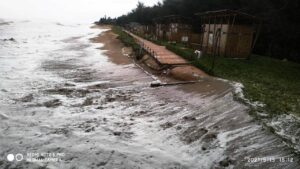
While humanity was affected, the cyclone took its toll also on the marine environment. The aftermath of Cyclone Tauktae (meaning ‘Gecko’) witnessed environmental groups like Terra Conscious lending a helping hand to Goa and other states, which resulted in the rescue of a juvenile Hawksbill Sea turtle — reported by Kayah & Katya Coelho from Baga beach. The turtle is undergoing treatment provided by Reefwatch & the state Forest Department.
The network was also informed of a young +Spinner+ dolphin that washed up dead in Patnem beach and a necropsy was performed by Reefwatch under the guidance of the Goa Forest Department, Puja Mitra, Founder, Terra Conscious, stated, adding that the network has witnessed over 400 incidents being reported to it since June 2017 – 2021.
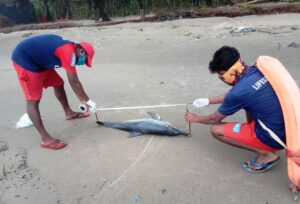
“Goa is home to a wide diversity of marine wildlife species, many of whom are protected under Schedule I of the Wildlife Protection Act of India, 1972. These include the Indian Ocean Humpback Dolphin & the Finless Porpoise, which are residential in Goa’s coastal waters. We also have regular nesting of the Olive Ridley Sea Turtle as well as coral reefs at Grande Island offshore from Vasco.”
“Goa also experiences frequent stranding incidents of marine species across it’s tiny coastline. A stranded animal such as a dolphin, sea turtle or sea bird may be dead or alive when it lands on a beach. They should only be handled by trained persons who have been given permission by the state Forest Department, (who is the custodian of all wildlife in the state) to do so.”
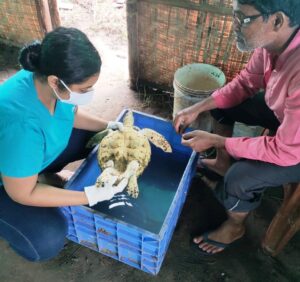
To monitor Goa’s coastline and respond to marine wildlife stranding incidents, the Goa State Forest Department in collaboration with Terra Conscious, IUCN India & Drishti Marine (lifesaving service) established a voluntary marine stranding response network in Goa in 2017.
“The lifeguards of Drishti Marine, Goa are the first responders of the network and training/coordination is provided by Terra Conscious. All rescue, treatment, necropsies etc are handled by the forest department,”
The government and NGOs have warned the public against touching any dead or injured marine creature stranded on the beach. “If you see a dead or injured marine animal on the beach: Please do not handle the animal yourself. There is a risk of zoonosis disease transfer and you may also end up injuring the animal further; All species of whales, dolphins, porpoises and sea turtles in India are given the highest protection in India under Schedule I of the Wildlife Protection Act of India, 1972. Handling them without forest department permission is a criminal offense. Hence please do not attempt to handle them on your own. Always report a stranded animal to the nearest lifeguard tower or call the Forest Department.”
In Maharashtra, 10 coastal districts were affected while 19 people and 11 cattle were killed, 81 structures fully damaged, 13,021 structures partially damaged in cyclone-related incidents, besides 13, 425 people evacuated to safety, according to disaster management authority officials. In Gujarat, around 79 people lost their lives in cyclone Tauktae-related incidents with Amreli district being worst-affected with 45 deaths.
TISS Researcher Amita Bhide said an odd fact going unnoticed in the cyclone rampage is marine waste – majority of which is often dumped carelessly by humans on the seas – being washed ashore in greater volumes and putting pressure on the municipalities cleaning manpower, especially in the wake of the Covid-19 pandemic keeping volunteers away.
Another strange fact is the horticulture crop being hit in the Konkan coastal region including Maharashtra, where the famed “Alphonso” breed of mango is grown. “The Alphonso mangoes are ripening at this time and the cyclone fury has impacted the financial benefits of these farmers, besides also the Cashewnut crop growers,” she said.
“This (Cyclone Tauktae) was not a natural cyclone,” Prof. Venkatray Nayak, marine biologist from Karnataka University, noted while poring through data of cyclonic storms occurring since 1900 in India. “Many boats and agricultural lands in Karnataka were damaged in the storm as saltwater surged into the fields affecting crops. Howeve, the cyclone came as a boon to fisherfolk as post-cyclone effects included seawater nutrients increasing and drawing fish in greater numbers shorewards to ensure a good catch.”
“The aftermath of a cyclone in 1974/75 highlighted the need for a Coastal Management Plan to prevent such natural disasters and, in 1991, the Coastal Zone Regulations Environmental Act was passed declaring 200 metres above high tide area as ‘No Development Zone.’ However, despite urging the Government in this regard, even today it’s not properly implemented but rather being modified for tourism and, as a result, lots of money is spent on the environment’s recovery from damage.”
“Earlier, sand dunes and mangroves were natural barriers against the encroaching seas and inclement weather, but today they are seen destroyed in many places. Maharashtra however has identified in Thane and Mumbai some mangroves as forests and protected them by clubbing them under the Forests, CRZ and Biodiversity Acts.”
“Cyclones occur when ocean waters evaporate in the bright sunlight, creating a ‘vacuum’ (low pressure area or Depression) several kms-long to form clouds and whirlpools, where wind enters the ocean and form waves that head off in the low pressure direction landwards.”
“Cyclone Tauktae is a rare phenomenon as it occurred too early (in summer) instead of near- monsoon time and there are possibilities of this happening in future. We attribute such unnatural disasters to climate change, global warming. The Arabian Sea is a small waterbody, compared to the Bay of Bengal and the Indian Ocean. So cyclone’s Tauktae’s effects should have been lesser than what happened now. Also, despite the IMD predicting the cyclone, the fishermen ventured into the sea on the Government’s watch.”
“Since protection of green cover including mangroves and sand dunes is a must, we urge the Government to speedy action in implementing CRZ notifications banning development in the 200 metres above high tide zone and evacuating everybody in that space,” Nayak added.


